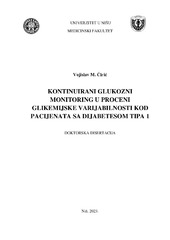Приказ основних података о дисертацији
Kontinuirani glukozni monitoring u proceni glikemijske varijabilnosti kod pacijenata sa dijabetesom tipa 1
| dc.contributor.advisor | Pešić, Milica | |
| dc.creator | Ćirić, Vojislav | |
| dc.date.accessioned | 2023-10-20T20:56:56Z | |
| dc.date.available | 2023-10-20T20:56:56Z | |
| dc.date.issued | 2023 | |
| dc.identifier.uri | http://eteze.ni.ac.rs/application/showtheses?thesesId=8626 | |
| dc.identifier.uri | https://fedorani.ni.ac.rs/fedora/get/o:1918/bdef:Content/download | |
| dc.identifier.uri | https://plus.cobiss.net/cobiss/sr/sr/bib/123162889 | |
| dc.identifier.uri | https://nardus.mpn.gov.rs/handle/123456789/21796 | |
| dc.description.abstract | Glycemic variability (GV) represents the fluctuations of glycemia between high and low values. Reduction of HbA1c below 7% is an accepted goal for most patients with type 1 diabetes (T1DM), however strict glycemic control increases the risk of hypoglycemia. Achieving successful glycemic control is only possible through reduction of GV. Methods of assessing and presenting GV are still a matter of debate. Self-monitoring of glycemia (SMBG) can only roughly estimate GV. Continuous glucose monitoring (CGM) is a modern method that, by frequent (1-5 min) and precise measurement of the level of glucose in the intestinal fluid over a longer period of time (3-7 days), provides the possibility of assessing GV. The aims of this study are to compare GV in patients with T1DM receiving multiple daily injections of insulin (MDI) and patients receiving continuous insulin infusion therapy (CSII), and then to examine the association of HbA1c results with GV parameters, the association of registered hypoglycemic episodes with HbA1c and GV, as well as the association of GV with quality of life and treatment satisfaction. The study included 60 patients with T1DM divided into two groups - patients treated by MDI and patients treated by CSII. The patients performed masked (professional) CGM for 6 days, with mandatory SMBG and recorded daily activities, meals and physical activity. The parameters determined by the CGM method are average glycemia, SD, estimated HbA1c, time in range (TIR), time above range (TAR), time below range (TBR), AUC (area under curve) for hyperglycemia and hypoglycemia. The following were aditionally calculated: CV, MAGE (mean amplitude of glycemic excursions), MAG change (mean absolute glucose change), MODD (mean daily difference of blood glucose), CONGA (continuous overall net glucose action), J-index, LI (lability index), M-value, GRADE (the glycemic risk assessment diabetes equation), GRADE Hyper, GRADE Hypo, ADDR (average daily risk range), HBGI (high blood glucose index), LBGI (low blood glucose index). General laboratory analyses, HbA1c, and serum markers of variability (1,5-anhydroglucitol- 1,5-AG and fructosamine) were determined for all patients. Quality of life was assessed with the SF-36 questionnaire, and treatment satisfaction was assessed with the DTSQ questionnaire. HbA1c value was lower in patients using CSII therapy compared to patients using MDI therapy, but the difference was not statistically significant. Some statistically significant advantages in the quality of glycemic control were observed in CSII group - lower average glycemia, AUC for hyperglycemia was lower, TIR was longer, TAR was shorter, HbA1c estimated by the software was lower, the number of hypoglycemic events below 3.0 mmol/l was lower and their duration was shorter, also the number of hyperglycemic events over 13.9 mmol/l was lower and their duration was shorter. CSII group had a significantly higher value of 1.5-AG. There was no significant difference in the quality of life except for some higher scores in CSII group- regarding limitations due to physical health and health change. There was a greater treatment satisfaction in CSII group. The CGM method detected asymptomatic hypoglycemic episodes in a large number of patients (90% in the MDI group, 83.3% in the CSII group) without significant difference between the groups. All parameters of glycemic variability were significantly lower in the subjects using CSII. The result of HbA1c significantly correlated with some investigated GV parameters such as HBGI and AUC for hyperglycemia, but not with parameters describing glycemic fluctuations. The HbA1c result also correlated with certain categories of hypoglycemia events, such as the number and duration of hypoglycemia below 3.9 mmol/l. GV parameters that most significantly correlate with hypoglycemia events were CV, CONGA, J-index, LBGI, GRADE, GRADE-Hypo, GRADE-Hyper (negative), AUC for hypoglycemia, AUC for hyperglycemia (negative). Scores from the SF-36 questionnaire generally do not correlate with GV parameters except for some results. The most correlations were obtained in the bodily pain scale, primarily with the parameters describing hyperglycemia, while the aspect of mental health and the social functioning scale strongly correlated with the parameters describing hypoglycemia. The result of the DTSQ questionnaire (treatment satisfaction) correlated negatively with SD, CONGA, J-index, GRADE, HBGI, MODD, ADRR, M-value, AUC for hyperglycemia. | en |
| dc.format | application/pdf | |
| dc.language | sr | |
| dc.publisher | Универзитет у Нишу, Медицински факултет | sr |
| dc.rights | openAccess | en |
| dc.rights.uri | https://creativecommons.org/licenses/by-nc-nd/4.0/ | |
| dc.source | Универзитет у Нишу | sr |
| dc.subject | Dijabetes mellitus tip 1, intenzivirana insulinska terapija, kontinuirana supkutana insulinska infuzija, glikemijska varijabilnost, hipoglikemija, kontinuirani glikemijski monitoring | sr |
| dc.subject | Diabetes mellitus type 1, multiple daily injections insulin therapy, continuous subcutaneous insulin infusion, glycemic variability, hypoglycemia, continuous glucose monitoring | en |
| dc.title | Kontinuirani glukozni monitoring u proceni glikemijske varijabilnosti kod pacijenata sa dijabetesom tipa 1 | sr |
| dc.type | doctoralThesis | |
| dc.rights.license | BY-NC-ND | |
| dc.identifier.fulltext | http://nardus.mpn.gov.rs/bitstream/id/155741/Doctoral_thesis_14152.pdf | |
| dc.identifier.fulltext | http://nardus.mpn.gov.rs/bitstream/id/155742/Ciric_Vojislav.pdf | |
| dc.identifier.rcub | https://hdl.handle.net/21.15107/rcub_nardus_21796 |



